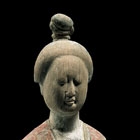J.J. Lally & Co., Oriental Art / New York City, New York
MenuPast Exhibition
Ancient Chinese Tomb Sculpture
March 22 - April 10, 2004
15.
A PAINTED AND GILDED WOOD FIGURE OF A COURT LADY
Tang Dynasty, A.D. 7th Century
the young woman shown standing quietly, wearing a high-waisted décolleté dress with close-fitting bodice and capped sleeves edged with gilding, her long skirt showing the remains of bright green pigment, hanging straight to the ground, the toes of her shoes just visible at the hem, with a bright red-painted shawl draped over her shoulders and decorated with fine gold tracery, her arms held in close to her waist, her left hand missing and her right hand concealed beneath her shawl, her face with serene expression and softly modelled features, her hair gathered up into a high topknot and painted black.
Height 16 1⁄2 inches (41.9 cm)
Several fragments of painted wood tomb figures including the heads of male and female figures in court dress, the head of a Central Asian, the legs of horses, and the head and torso of a lokapala, all discovered in 1985 in Tang dynasty tombs at Yanchi in Ningxia province, northwestern China, are illustrated in an excavation report in Wenwu, 1988, No. 9, pp. 43-56.
A pair of wood figures of female attendants in the William Rockhill Nelson Gallery of Art – Atkins Museum of Fine Arts, Kansas City, exhibited at the Portland Art Museum in 1976, are illustrated by Donald Jenkins in the catalogue entitled Masterworks in Wood: China and Japan, Portland Art Museum, 1976, pp. 28-29, no. 8, dated to the Sui dynasty, circa A.D. 600.
A simple carved wood figure of a courtesan of the so-called ‘fat lady’ type, with traces of painted decoration in black and colors, excavated from a Tang site in Qinghai is illustrated in A Selection of the Treasure of Archeological Finds of the People’s Republic of China 1976-1984, Beijing, 1987, no. 376.
Compare also the three Tang dynasty painted wood figures shown in the Kaohsiung Museum of Fine Arts and illustrated in the catalogue entitled Ancient Chinese Sculptural Treasures: Carvings in Wood, Kaohsiung, Taiwan, 1998, cat. nos. 38-40.
